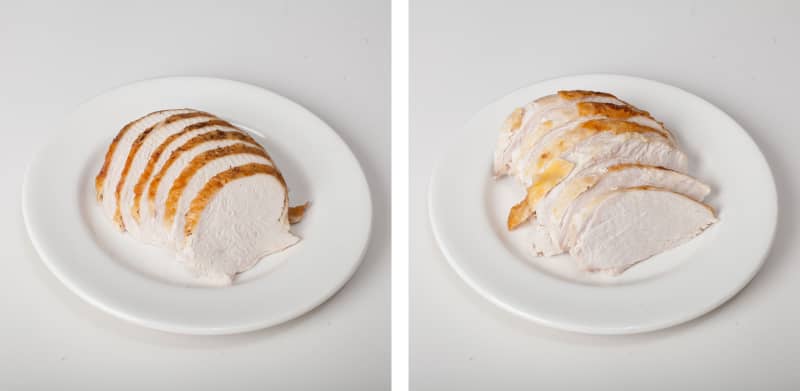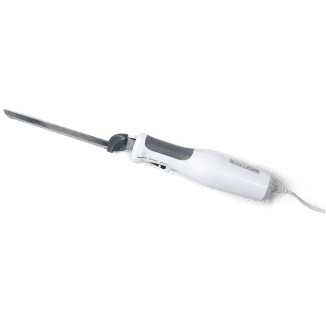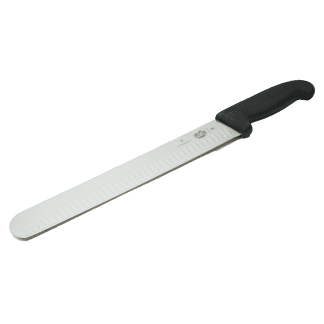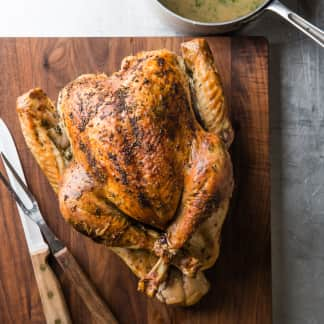The best electric knives are sharp, relatively quiet, and easy to use. Our longtime favorite is the Black + Decker ComfortGrip 9" Electric Knife, which made it a pleasure to carve turkey and chicken. It also has a safety lock so you won’t accidentally activate the blade when you don’t want to, and it comes with a handy storage case as well.

Electric knives may seem like relics of the past, but they’re still shimmying away in 21st-century kitchens. An electric knife has two identical serrated blades, riveted together, which are snapped into a motorized base that doubles as the knife’s handle. At the touch of the start button, these dual blades move in opposite directions—one forward, one backward—which creates a sawing motion that cuts food with minimal downward pressure. In theory, this makes them useful for delicate items, such as breads and other baked goods, that you want to cut without squishing, and they’re especially good for cutting skin-on poultry without ripping or pulling the skin.
We’ve had mixed luck with these motorized knives over the years, and we still have a few caveats. In our experience, they’re usually not very good at slicing bread: Their blades are generally too flexible to get purchase on any loaf, and instead, they wobble and make uneven cuts. (We think you’re better off using a standard bread knife.) The blades are also quite short—most measuring slightly less than 7 inches in length—so they can’t be used for truly large roasts or briskets. And they’re quite loud, making enough of a racket that we had to raise our voices to be heard while using them.
That said, the best electric knives can be very good indeed at carving roasts and even turkeys. Those slightly flexible, thin blades act like those of a boning knife, making clean slices and cleaving closely to the bone when we need them to. While most of the professional cooks we surveyed still prefer using a boning knife or chef’s knife to carve a roast, we think an electric knife can be a very effective alternative—as long as you choose the right one.

What to Look For
- Sharp Blades: Electric knives have a motor to provide extra power for slicing, but sharp blades are still critical for making clean slices easily. The best models were able to slice roast turkey and chicken breasts without tearing or damaging the crisp, delicate skin.
- Comfortable Handles: The best models had rounded handles that felt good in our hands, vibrated minimally, and stayed cool during use.
- Start Buttons on the Underside of the Handle: These were the easiest to press and keep engaged while we sliced.

- Relatively Quiet Operation: None of the electric knives we tested were exactly quiet, but we preferred those that were less ear-shatteringly loud than others.
- A Safety Lock: We appreciated that most knives had a small toggle designed to lock the start button and prevent accidental starting. A lock proves especially useful if you plan to carve roasts during big family gatherings.

Nice to Have
- A Storage Case: These helped keep the knives safe and contained when not in use.

What to Avoid
- Dull Blades: These made it harder to slice foods cleanly.
- Uncomfortable Handles: A few models had handles with angled edges that dug into our palms. One model vibrated heavily during use, which was very uncomfortable; another had a handle that got quite warm while we were working. We docked comfort points from all.

- Bad Start Button Design: Two knives had start buttons on top of the handle for users to press with their thumbs, and two knives had buttons underneath the handle for users to press with their index fingers. We disliked start buttons on top—our thumbs hurt after using those models. One especially uncomfortable knife forced us to press a ridged button down and forward, which put our thumbs into an awkward, painful position and left an imprint on them.
- Loud Operation: Two models were gratingly loud. We measured each knife’s volume using a decibel meter, and these two registered a whopping 88 and 89 decibels—nearly as loud as a lawn mower. (By comparison, normal conversation is about 60 decibels.) The loudest knife sounded like “a little chainsaw,” according to one tester, and we were asked to relocate during testing because people nearby had trouble talking over the noise. We couldn’t imagine using this knife during the holidays with friends and family around as its roaring motor would quell all conversation.
Other Considerations
- Extra Blades: Some models came with an extra set of blades that weren’t serrated. We didn’t find these to be useful since they weren’t very sharp or effective to begin with.
The Tests
- Slice 1 loaf of challah bread ½ inch thick and ¼ inch thick
- Slice 1 loaf of Japanese milk bread ½ inch thick and ¼ inch thick
- Slice 1 loaf of Francese bread ½ inch thick and ¼ inch thick
- Slice 1 rotisserie chicken into ¼-inch-thick and ⅛-inch-thick slices
- Carve 1 whole roasted turkey into ¼-inch-thick and ⅛-inch-thick slices
- Slice 10 loaves of Francese bread ½ inch thick and ¼ inch thick (winner only)
- Measure noise level using decibel meter
How We Rated
- Comfort: We rated the knives on how comfortable thy were to hold and operate.
- Slicing Ability: We evaluated the knives on how easily they carved uniform slices of bread and poultry.
- Noise Level: We rated the knives on how loud they were during use.














